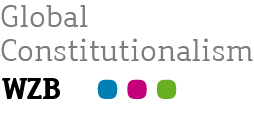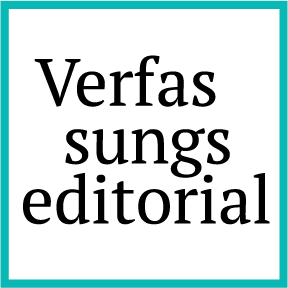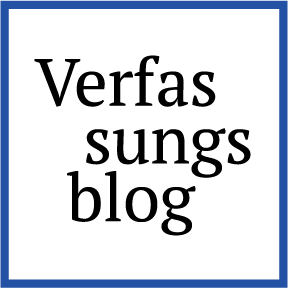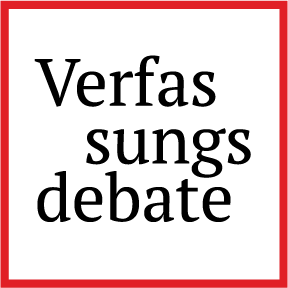Who is In, Who is Out?
Verfassungsblog’s Response to its Removal from DOAJ
In our blog post “Access Denied”, we informed the research and Open Access (OA) community about Verfassungsblog’s removal from the Directory of Open Access Journals (DOAJ). With the publication of our appeal – which was ultimately rejected by DOAJ – we also announced our intention to initiate a broader discussion with DOAJ and the OA community about the directory’s admission and removal processes. As DOAJ is a central and established instrument in the Open Access movement, we believe this discussion is vital.
To enable an open and constructive conversation, I will revisit the arguments from our appeal and connect them to broader issues of Open Access publishing, funding, and DOAJ’s role in this process. Since Matt Hodgkinson, Head of Editorial at DOAJ, has recently published DOAJ’s response, I will engage with some of his key points.
DOAJ’s role in the Open Access movement
In 2003, Lund University launched the registry for OA Journals, just one year after the Budapest Open Access Initiative was declared, and in the same year as the Bethesda Statement on Open Access Publishing and the Berlin Declaration on Open Access to Knowledge in the Sciences and Humanities. This timing was not a coincidence, as the necessity for such a registry had become very clear in the early years of the OA movement. Its establishment underlined DOAJ’s central importance for the success of Open Access. In Germany, in particular, DOAJ plays a crucial role in making funding decisions. The German Research Foundation (DFG), for example, explicitly refers to DOAJ in its funding criteria, using the directory as a benchmark for ensuring quality standards and peer review in OA journals.1)
From early on, DOAJ functioned not merely as a directory but as a tool for quality assurance in academic publishing. The question extended beyond whether the journal was open access, to whether it met minimum criteria for scholarly integrity and peer review. The spectre of “predatory publishing” – businesses exploiting article processing charges for profit – only heightened the need for such oversight.
Unsurprisingly, this task sparked ongoing debates in the OA world, such as whether ‘mirror journals’ should be included. As Michaela Voigt notes in her article “Mirror mirror on the wall… targeted detection of ‚mirror journals‘” mirror journals remain in DOAJ despite being viewed with scepticism by many institutions:
“This leaves the Directory of Open Access Journals (DOAJ) as a possible working aid for OA administration. The DOAJ criteria catalogue would have to be completely revised though if one wanted to exclude MJs.”
Our experience with the removal process
Our experience with Verfassungsblog’s removal from DOAJ left us puzzled and doubtful as to whether the DOAJ’s current processes and criteria accurately reflect its importance and influence in the OA landscape. Since the publication of our appeal, we have received feedback from several institutions expressing similar concerns. We want to open up this conversation to advocate for a fair and transparent process – one that acknowledges DOAJ’s significance, not just for the OA community in general, but especially for small, non-profit publishers that are key drivers of the Diamond Open Access model. Given DOAJ’s importance for OA publishing, transparency around acceptance and removal is essential: What are the exact criteria for inclusion? How is removal determined? Being delisted without prior notice or the opportunity to respond is especially concerning for small publishers and journals that lack the resources to react quickly and to secure alternative funding.
We are very glad to learn that DOAJ’s decision process has been improved since Verfassungsblog’s removal, and that the importance of the opportunity and time for smaller publishers to give feedback and to prepare for a potential removal has been acknowledged. We agree that the criteria mentioned in the list of removed journals are insufficient to explain why journals are being removed.
As we detailed in our appeal, DOAJ did not clearly communicate any new criteria or standards to included journals. At the time of our initial acceptance, it was understood that the use of external peer reviewers was optional and that our format is somewhat different from traditional journal formats, including the fact that citations appear primarily as hyperlinks. The reasons given for our removal were already known at the time of our acceptance, raising the question of whether the standards have since changed or were interpreted differently by individual reviewers.
If the standards have indeed shifted towards a stricter interpretation of quality assurance, this should have been clearly communicated. Either way, the process lacked transparency and clarity and opens up a broader debate whether these new criteria properly reflect the diversity in science publishing, with a view to the fact that when it comes to funding by libraries a DOAJ listing is often a do-or-die matter.
Peer review and scholarlyness
DOAJ’s critique of Verfassungsblog’s scientific quality touches at the very core of our mission. While we do not follow a traditional journal format, we uphold high standards of scholarly rigour and aim to facilitate timely, readable contributions on pressing legal and constitutional issues. Our review process and scholarly standards are outlined in detail in our appeal and are tailored to a specific format. However, DOAJ’s reasoning raises broader concerns about how journals are evaluated.
DOAJ questioned our editorial model, claiming that editorial review is acceptable only in the arts and humanities. As explained in our appeal, Verfassungsblog does not rely solely on editorial review. Our approach is consistent with practices widely accepted in the German legal publishing community (see for details and references our appeal). The result is an absurd paradox: Verfassungsblog is recognized as a respected scientific resource in Germany, yet DOAJ does not acknowledge its scientific value.
If DOAJ defines ‘scientific’ in a narrow and specific sense and exclusively accepts international general standards regarding peer review, this should have been explicitly stated in its admission guidelines. Otherwise, it risks enforcing standards that are stricter than those applied for closed-access journals, which may have more latitude to experiment with open peer review or other innovative models.
Hodgkinson lists four reasons for Verfassungsblog’s removal, one of which has been resolved in the meantime:
- Not a research journal
- Not peer reviewed
- Lack of scholarly referencing
- information on webpage (resolved)
Point 1 results from point 2 and 3 and is therefore redundant. Point 2 is factually incorrect as outlined on our webpage. Point 3 is misleading: we use hyperlinks to avoid disrupting the reading flow, but our content is properly referenced.
The need for innovations in publishing
The Coalition for Advancing Research Assessment (CoARA) principles emphasize the need to reform scientific publishing – a goal long championed by the OA movement which has historically faced accusations of being “unscientific”. Ironically, Open Access publications may now be held to more rigid standards than their closed-access counterparts.
This is reflected not just in the line of argument regarding our review process, but also concerns Verfassungsblog’s format. Understandably, traditional journals appear easier to navigate and to understand in terms of workflows. If questioning or changing these traditional structures is considered “unscientific” per se, that would effectively block all potential innovation.
Verfassungsblog is not alone in the German legal publishing world in using tools like WordPress instead of traditional systems like OJS. As noted by Nikolas Eisentraut and Hanjo Hammann in their Handbuch Open Science/ Rechtswissenschaft:
„Juristische Internetzeitschriften aus dem deutschsprachigen Raum verwenden meist Blogsysteme oder selbstprogrammierte Websites anstelle spezialisierter Publikationssoftware (wie OJS) und vergeben keine persistenten Identifikatoren (wie DOI). Dementsprechend sind nur wenige deutsche Rechtszeitschriften in DOAJ indiziert, so dass der Eindruck entstehen könnte, in der deutschen Rechtswissenschaft werde bisher noch gar nicht Open Access publiziert.“2) (Translation below)
This disconnect between the criteria used by DOAJ and the realities of German legal publishing is not accidental. In a context where large commercial publishers dominate the legal publishing market and a conservative publishing culture resists openness, Open Access is often driven by scholars with a strong commitment not just to academic integrity but also to public engagement. This, surely, aligns with the very ethos of the OA movement.
At Verfassungsblog, we encourage authors to write in an accessible style – not to sacrifice scholarly standards, but to make research available beyond the confines of the ivory tower.
According to Hodgkinson’s own definition, “a scholarly journal has an ISSN, editorial oversight, and (usually) peer review, and is aimed at a scholarly or academic audience, i.e., those interested in the systematic study of learning and knowledge.” By these criteria, we qualify. However, we believe that speaking to an academic audience does not necessitate an overly abstract or technical style.
DOAJ and the future of Open Access
DOAJ rightly highlighted areas in which we can improve, including transparency on our website. As a project driven largely by legal scholars, Verfassungsblog is undergoing a process of professionalisation, and we are committed to constructive engagement with the OA community. There are many things we can do better. But we are not a and do not want to be a traditional journal. Our difference is a feature, not a flaw.
The DOAJ rejection was deeply discouraging, especially as we always viewed the OA community as one driven by a shared mission to challenge a dysfunctional system and to support grassroots innovation.
By publishing this response, we hope to foster an open debate with DOAJ, the OA community and other publishers and researchers. We are genuinely curious about other views and different perspectives. What are DOAJ’s long-term goals? Does it have the resources to meet the responsibilities that come with its growing influence? How can we ensure that the Open Access movement remains open to experimentation rather than building new barriers?
The debate prompts reflection on DOAJ’s function within the OA world and Open Science in general. While it rightly protects against predatory publishing or ‘double-dipping’, it also risks excluding valuable and trusted platforms. This raises another important question: How should libraries approach funding decisions when resources deemed unworthy of DOAJ inclusion are nonetheless respected and relied upon?
As Hodgkinson writes:
“We understand that some institutions and communities use DOAJ indexing as a criterion for funding decisions, but rejection or removal from the index is not always based on poor practice but rather on not being the kind of publication we consider. We hope funders will bear this in mind.”
However, simply pointing out that institutions should not rely on DOAJ for funding decisions clearly will not do. In response to his question regarding what types of journals ought to be included, we would like to offer the following perspective:
German law journals should not be required to adhere strictly to the international standard of double-blind peer review.
Law blogs and internet-based journals that implement peer-review practices should be recognized as scholarly journals – if necessary, within a new category.
If Verfassungsblog is regarded as a trustworthy platform of scientific debate, it must receive the funding and support necessary for its continued existence. Open Access researchers already contend with entrenched prejudices within the conservative publishing culture that dominates German legal scholarship. At the same time, the constitutional and democratic structures we engage with are increasingly under threat.
Besides the procedural concerns raised by our removal from DOAJ, the central questions remain: Is Verfassungsblog a trusted academic resource deserving of funding? If its place is not within the DOAJ, then where should it be? And what role does DOAJ envision for itself in promoting and supporting Open Access, particularly for non-traditional or emerging formats?
References
| ↑1 | DFG has recently announced its new cooperation with DOAJ and referred in the announcement to the importance of DOAJ for funding decisions |
|---|---|
| ↑2 | Handbuch Open Science/ Rechtswissenschaft – Wikibooks, Sammlung freier Lehr-, Sach- und Fachbücher. Translation: “Legal internet journals from German-speaking countries mostly use blog systems or self-programmed websites instead of specialized publication software (such as OJS) and do not assign persistent identifiers (such as DOI). As a result, only a few German law journals are indexed in DOAJ, which could give the impression that German legal scholars have not yet published Open Access at all.” |




To me the actual issue lies indeed in the fact that the DOAJ was founded and designed from the perspective of a very traditional understanding of scholarly journals. It started more inclusive very early but became more rigorous over time, which also means it went more conservative in this regard. This lead to the categorial differences that are difficult if not impossible to resolve when it comes to publication formats that follow a different logic, such as Verfassungsblog.
A simple solution would be for the DOAJ to add a separate additional category for scientific publications such as blogs and develop its own appropriate quality criteria for those types. The infrastructure can be probably used as it is. All it needs is an appropriate filter for publication type.
And if, also understandably, DOAJ would not be interested in evolving that way, there is obviously a demand for a new directory to compile high-quality less traditional scholarly publication formats. (Which, btw, sounds like a lovely project. Who will write the proposal?)